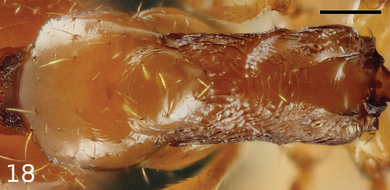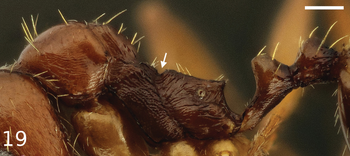Aphaenogaster ichnusa
| Aphaenogaster ichnusa | |
|---|---|
| Scientific classification | |
| Kingdom: | Animalia |
| Phylum: | Arthropoda |
| Class: | Insecta |
| Order: | Hymenoptera |
| Family: | Formicidae |
| Subfamily: | Myrmicinae |
| Tribe: | Attini |
| Genus: | Aphaenogaster |
| Species group: | subterranea |
| Species: | A. ichnusa |
| Binomial name | |
| Aphaenogaster ichnusa Santschi, 1925 | |
Aphaenogaster ichnusa inhabits areas with a Mediterranean climate. Its colonies are often found nesting under rocks, and it is especially abundant in shady forest habitats with sufficient humidity and leaf litter (Schifani et al. 2023) (Zięcina et al., 2024).
Identification
Zięcina et al. (2024) - A member of a complex of species with a head partly smooth and shiny. This complex comprises Aphaenogaster asterioni, Aphaenogaster holtzi, A. ichnusa and Aphaenogaster subterranea.
Aphaenogaster ichnusa is the most similar to A. subterranea and differs in almost entirely smooth pronotum, often lacking longitudinal costulae on its lateral sides and smaller propodeal spines that are often reduced to a denticle. Aphaenogaster holtzi differs in uniformly pale yellow body and the presence of numerous erect setae in the occipital part of the head. See also diagnosis for Aphaenogaster asterioni.
 Zięcina et al. (2024), Figure 51. Spatial genetic structure of A. epirotes (a), A. ichnusa (d), A. subterranea (g) and A. tristis (j) and their respective haplotype networks (b,e,h,k) based on COI sequences. Colours match the bidimensional colour space of the PCoA projection (c,f,i,l). Insets show the max intraspecific p-dist.
Zięcina et al. (2024), Figure 51. Spatial genetic structure of A. epirotes (a), A. ichnusa (d), A. subterranea (g) and A. tristis (j) and their respective haplotype networks (b,e,h,k) based on COI sequences. Colours match the bidimensional colour space of the PCoA projection (c,f,i,l). Insets show the max intraspecific p-dist.
Keys including this Species
- West European Aphaenogaster subterranea group species (queens and males)
- Key to Aphaenogaster subterranea species-group
Distribution
Schifani et al. (2023) - Aphaenogaster subterranea has a wide distribution, from Iberia to Anatolia, and north to central Europe, while the range of A. ichnusa is restricted to West Europe and does not occur in the Balkans (Borowiec and Salata pers. comm., 2022; MM unpublished data). Until recent years A. ichnusa was considered as a Sardinian endemic and a subspecies of A. subterranea. Their separation as two distinct species was only recently demonstrated based on worker morphology and mitochondrial DNA (Galkowski et al. 2019). The recent recognition implies that reliable data over the distribution of the two species is scarce in the sympatric range, where they were historically confused. Apart from Sardinia, Galkowski et al. (2019) reported the presence of A. ichnusa in Corsica and southern mainland France. More recently, only a few scattered records were published from mainland Italy, Sicily, and mainland Spain (Schifani and Alicata 2018; García et al. 2020; Schär et al. 2020; Zara et al. 2021; Bazzato et al. 2022; Scupola et al. 2022). However, a detailed picture of the distribution of A. ichnusa and A. subterranea in these regions is lacking.
Latitudinal Distribution Pattern
Latitudinal Range: 43.443° to 36.9°.
| North Temperate |
North Subtropical |
Tropical | South Subtropical |
South Temperate |
- Source: AntMaps
Distribution based on Regional Taxon Lists
Palaearctic Region: France, Italy (type locality), Spain.
Distribution based on AntMaps
Distribution based on AntWeb specimens
Check data from AntWeb
Countries Occupied
| Number of countries occupied by this species based on AntWiki Regional Taxon Lists. In general, fewer countries occupied indicates a narrower range, while more countries indicates a more widespread species. |

|
Estimated Abundance
| Relative abundance based on number of AntMaps records per species (this species within the purple bar). Fewer records (to the left) indicates a less abundant/encountered species while more records (to the right) indicates more abundant/encountered species. |

|
Biology
Schifani et al. (2023) - Colonies of A. ichnusa and A. subterranea are often found nesting under rocks, and both species may be especially abundant in shady forest habitats with suffcient humidity and leaf litter (Castracani et al. 2010, referring at least part of the records to A. ichnusa based on voucher checked; Seifert 2018, assuming Central-European records to represent A. subterranea; Zara et al. 2021; Bazzato et al. 2022). Albeit rarely, at least A. ichnusa may adapt significantly to urban environments: in summer days, we observed workers foraging in a shady courtyard entirely made of concrete within a historic palace of Florence.
However, despite their ecological success and wide distribution, still relatively little is known about the habits of these species besides anecdotal reports. They are probably mostly predators and scavengers, but at least A. ichnusa was also observed by the authors to tend root aphids, suggesting that trophobiosis may also play an important role in the diet of both. In addition, we observed isopods (Platyarthrus sp.), oribatid mites, silverfish, leaf beetle larvae (Chrysomelidae: Clytrinae), and planthoppers nymphs (Cixiidae) in A. ichnusa nests, and isopods (Platyarthridae) in A. subterranea nests, in which also Cixiidae were reported by Lörinczi (2012). In shady habitats, we observed minimal daytime foraging by both species. However, on other occasions, workers of A. ichnusa mostly started to forage outside the nest at dusk. Perhaps the foraging activity is often conducted within the leaf litter or in endogean microspaces, but none of these species is truly subterranean (Ortuño et al. 2014).
Some of us also observed cooperative food transport in A. subterranea at least. Furthermore, A. subterranea workers are known to use tools: they drop small debris into liquid food and transport food-soaked tools back into their nest (Lőrinczi et al. 2018; Módra et al. 2022). This behavior is deemed to be a complex strategy developed to compensate for the inability to ingest and carry into the body large quantities of liquid food (Lőrinczi et al. 2018; Módra et al. 2022). Notably, we found multiple times numerous dealate queens (up to five) in some colonies of A. ichnusa and A. subterranea, suggesting at least occasional polygyny in both species.
Castes
Worker
Phylogeny
| Aphaenogaster subterranea species group |
| ||||||||||||||||||||||||||||||||||||||||||
Based on Zięcina et al. (2024).
Nomenclature
The following information is derived from Barry Bolton's Online Catalogue of the Ants of the World.
- ichnusa. Aphaenogaster (Attomyrma) subterranea var. ichnusa Santschi, 1925g: 341 (w.) ITALY (Sardinia).
- Type-material: syntype workers (number not stated).
- Type-locality: Italy: Sardinia I., Sorgono (A.H. Krausse, A. Reichensperger).
- Type-depository: NHMB.
- Schifani, Alicata, Borowiec, et al. 2023: 147, 145 (q.m.).
- Subspecies of subterranea: Finzi, 1930a: 155; Baroni Urbani, 1971c: 56; Bolton, 1995b: 70; Poldi, et al. 1995: 3.
- Status as species: Galkowsky, et al. 2019: 423 (redescription); Schifani, Alicata, Borowiec, et al. 2023: 145.
- Distribution: France (+ Corsica), Italy (+ Sardinia, Sicily), Spain (+ Balearics).
Description
References
- Alicata, A., Schifani, E. 2019. Three endemic Aphaenogaster from the Siculo-Maltese archipelago and the Italian Peninsula: part of a hitherto unrecognized species group from the Maghreb? (Hymenoptera: Formicidae: Myrmicinae). Acta Entomologica Musei Nationalis Pragae. 59(1):1–16. doi:10.2478/aemnp-2019-0001
- Galkowski, C., Aubert, C., Blatrix, R. 2019. Aphaenogaster ichnusa Santschi, 1925, bona species, and redescription of Aphaenogaster subterranea (Latreille, 1798) (Hymenoptera, Formicidae). Sociobiology 66: 420-425 (doi:10.13102/sociobiology.v66i3.3660).
- Santschi, F. 1925g. Fourmis d'Espagne et autres espèces paléarctiques (Hymenopt.). EOS. Rev. Esp. Entomol. 1: 339-360 (page 341, worker described)
- Schär, S., Menchetti, M., Schifani, E., Hinojosa, J.C., Platania, L., Dapporto, L., Vila, R. 2020. Integrative biodiversity inventory of ants from a Sicilian archipelago reveals high diversity on young volcanic islands (Hymenoptera: Formicidae). Organisms Diversity, Evolution 20, 405–416 (doi:10.1007/s13127-020-00442-3).
- Schifani, E. (2022). The new checklist of the Italian fauna: Formicidae. Biogeographia – The Journal of Integrative Biogeography 37, ucl006 (doi:10.21426/b637155803).
- Schifani, E., Alicata, A., Borowiec, L., García, F., Gentile, V., Gómez, K., Nalini, E., Rigato, F., Schär, S., Scupola, A., Vila, R., Menchetti, M. 2023. Unrecognized for centuries: distribution and sexual caste descriptions of the West European Aphaenogaster species of the subterranea group (Hymenoptera, Formicidae). ZooKeys 1153, 141–156 (doi:10.3897/zookeys.1153.98297).
- Schifani, E., Alicata, A., Menchetti, M., Borowiec, L., Fisher, B.L., Karaman, C., Kiran, K., Oueslati, W., Salata, S., Blatrix, R. 2022. Revisiting the morphological species groups of West-Palearctic Aphaenogaster ants (Hymenoptera: Formicidae) under a phylogenetic perspective: toward an evolutionary classification. Arthropod Systematics & Phylogeny 80, 627–648 (doi:10.3897/asp.80.e84428).
- Schifani, E., Csősz, S., Viviano, R., Alicata, A. 2021. Ant diversity on the largest Mediterranean islands: on the presence or absence of 28 species in Sicily (Hymenoptera, Formicidae). Natural History Sciences 8, 55–70 (doi:10.4081/nhs.2021.532).
- Schifani, E., Nalini, E., Gentile, V., Alamanni, F., Ancona, C., Caria, M., Cillo, D., Bazzato, E. 2021. Ants of Sardinia: An updated checklist based on new faunistic, morphological and biogeographical notes. Redia 104, 21–35 (doi:10.19263/redia-104.21.03).
- Zięcina, D., Menchetti, M., Borowiec, L., Bračko, G., Lapeva-Gjonova, A., Vila, R., Salata, S. 2024. Taxonomic revision of the Aphaenogaster subterranea species group (Hymenoptera: Formicidae). Annales Zoologici 74(2): 237-282 (doi:10.3161/00034541anz2024.74.2.002).
References based on Global Ant Biodiversity Informatics
- Baroni Urbani, C. "Studi sulla mirmecofauna d'Italia. II. Formiche di Sicilia." Atti dell'Accademia Gioenia di Scienze Naturali in Catania (6) 16 (1964): 25-66.
- Finzi B. 1930. Contributo allo studio degli Aphaenogaster paleartici (Formicidae-Myrmicinae). Bollettino della Società Entomologica Italiana 62: 151-156.
- Galkowski C., C. Aubert, and R. Blatrix. 2019. Aphaenogaster ichnusa Santschi, 1925, bona species, and Redescription of Aphaenogaster subterranea (Latreille, 1798) (Hymenoptera, Formicidae). Sociobiology 66(3): 420-425.
- Poldi B., M. Mei, and F. Rigato. 1995. Hymenoptera, Formicidae. Vol 102. Checklist delle specie della fauna Italiana: 1-10.
- Santschi, F. "Fourmis d'Espagne et autres espéces paléartiques." EOS (Revista española de entomología) 1 (1925): 339-360.
- Schifani E., and A. Alicata. 2018. Exploring the myrmecofauna of Sicily: thirty-two new ant species recorded, including six new to Italy and many new aliens (Hymenoptera, Formicidae). Polish Journal of Entomology 87 (4): 323–348.




